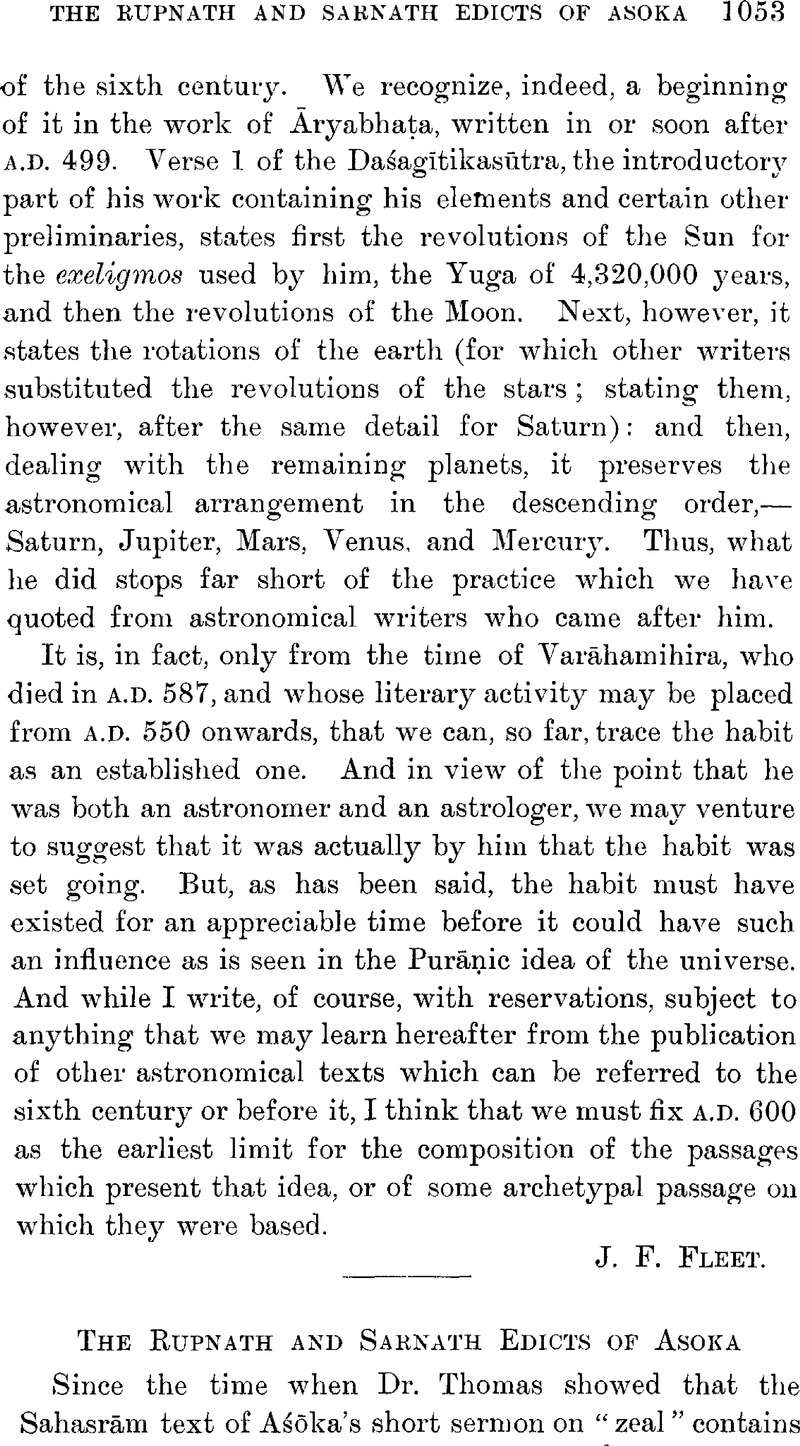No CrossRef data available.
Published online by Cambridge University Press: 15 March 2011

page 1054 note 1 Journal Asiatique, serie 10, tome 15 (1910, part 1), p. 520.
page 1054 note 2 Id., tome 17 (1911, part 1), p. 119.
page 1054 note 3 This Journal, 1911, p. 1106.
page 1055 note 1 See this Journal, 1911, p. 168, footnotes 1 and 2, and p. 169, footnote 1. As pointed out by Senart, M. (Comptes Sendus des Séances de l' Académie des Inscriptions et Belles-Lettres, 1907, p. 28)Google Scholar, āvāsayiye is the optative passive of āvāsayati.
page 1055 note 2 Journal Asiatique, série 10, tome 10 (1907, part 2), p. 129.
page 1055 note 3 For the reading puta-papotikt chaṁdama-sūriyike see this Journal, 1911, p. 167 f.
page 1056 note 1 Lahiye may be derived from the root labh; cf. the optative passive āsayiye in 1. 4 of the Kosambi edict and in 1, 5 of the Sārnāth edict.
page 1056 note 2 Cf. this Journal, 1911, p. 168, where I have pointed out that the reading of the stone is not sarṁghasa mage, but saṁghe samage, and see the Pātimokkha (id., 1876, p. 75, § 10): samaggo hi saṁgho … phām viharati.
page 1056 note 3 ProfessorVenis, (Journ. and Proc. As. Soc. Bengal, 1907, vol. 3, p. 2Google Scholar) was the first to translate nikship by “inscribing”. That he is right appears from the Raglmvaṁśa, vii, 65, where Mallinātha explains nikshēpita by lēkhita.
page 1056 note 4 Literally, “one edict of this description.”
page 1056 note 5 Senart, M. (Comptes Rendus, 1907, p. 30)Google Scholar explains huvāti as subjunctive. Cf. the Māhārashṭrī form huvanti in Pischel' Grammatik, § 476.
page 1057 note 1 Senart, M. (Comptes Sendus, 1907, p. 30 ff.)Google Scholar is probably right in considering saṁsalana (= Sanskrit saṁsaraṇa) as the designation of some locality. Professor Venis, (Journ. and Proc. As. Soc. Bengal, 1907, vol. 3, p. 2)Google Scholar translates it by “place of assembly”.
page 1057 note 2 Of this word only the two first syllables are preserved at the beginning of 1. 3.
page 1058 note 1 As Dr. Thomas (p. 517) notes, the usual Pāli equivalent of vivasati is vippavanati; see Childers, s.v. DrVogel, (Ep. Ind., vol. 8, p. 171)Google Scholar justly remarks that vivāsayati, though a causative in form, can hardly have a causative meaning, as it is followed in the second clause by vivāsāpayati, which can be nothing but a causative of vivāsayati. The form vivaseti at Rūpnāth (1. 5) may be either a Prākṛit variant of vivasati (cf. Pischel's, Grarnmatik, § 472Google Scholar) or a clerical mistake for vivāseti.
page 1058 note 2 See Childers, Pali Dictionary, s.v. vyañjanaṁ, and note the antithesis between aṭha and viyaṁjana in 11. 4 and of the Rūpnāth text.
page 1058 note 3 The word “proclamation” (sāvana) occurs in 11. 3 and 5 of the Rūpnāth edict. Cf. the Delhi-Siwālik pillar edict vii, 11. 20 and. 22, where Aśōka states that he has issued “proclamations on morality” (dhṃma-sāvanāni).